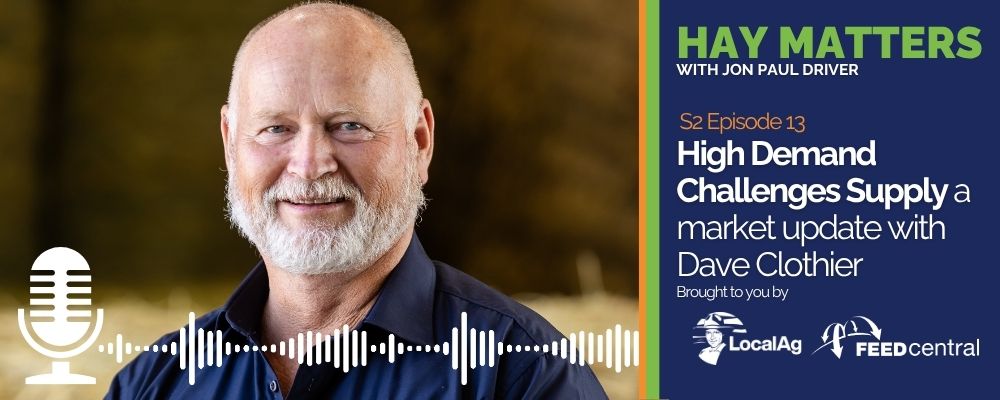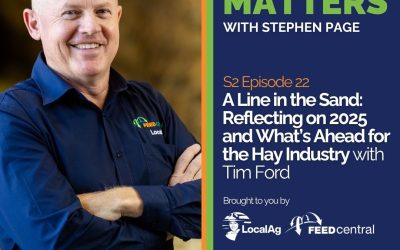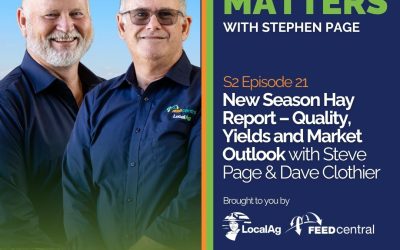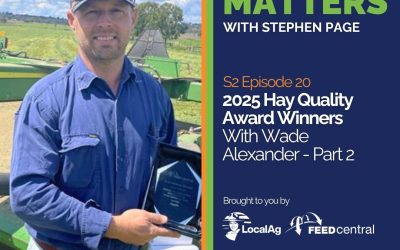
Podcast Highlights
In this episode of Hay Matters, brought to you by LocalAg and Feed Central, Jon Paul Driver is joined by National Sales Manager Dave Clothier to unpack current fodder market conditions. With drought in the south driving record demand and pushing prices up fast, Dave explains what’s moving across the country and what’s not — and what buyers and sellers need to know as an early northern season begins to take shape.
- April and May marked one of the busiest trading periods Feed Central has seen in over 20 years, as drought across southern NSW, Victoria and SA pushed up demand
- Many southern growers held onto hay, concerned the dry conditions would extend north, which further tightened supply during a period of rapidly increasing demand
- Rain has restored some confidence but feed shortages are expected to continue for six to eight weeks while pasture growth catches up
- While Western Australia and Northern Territory have good supply, biosecurity restrictions and high freight costs are limiting movement east
- Prices are sitting above $400 ex farm for cereal hay and $600 for lucerne, with freight adding up to $350 per tonne and some landed prices topping $700
- In some cases straw is being transported long distances to fill gaps in southern supply and buyers are feeding at any cost to retain core breeding herds
- Northern Australia is set for an early season with cereal hay cuts expected from mid July while southern crops remain four to six weeks behind
- With the new financial year underway, more growers are releasing hay to the market but windows are narrow and buyers should act quickly
- Price pressure is expected to remain until southern yield prospects become clearer
Read Transcript
Jon Paul Driver 0:00
Dave, welcome to the Hay Matters podcast brought to you by Feed Central and LocalAg, today on the podcast, I’m joined by Dave Clothier. He’s the National Sales Manager at Feed Central’s LocalAg, welcome back.
Dave Clothier 0:21
Thanks, JP, been a while between drinks, mate. Been a busy few months, and a lot’s transpired since our last chat.
Jon Paul Driver 0:28
Now this is a primarily market focused episode here, so let’s dive into those supply and demand characteristics associated with I mean, the big story is the drought, right?
Speaker 1 0:39
Yeah, yeah. Certainly has been. I took leave at the start of April. Was away from most of April. When I left, I was going overseas, demand, we just started to get a sniff that demand was going to lift. Soon as I left the country, it just went through the roof, so much to the point that I think it’s the busiest period April and May, that Tim Ford in 22 years with Feed Central has seen so quite remarkable change, and that’s primarily because of the drought situation in Southern Australia. And when I say southern Australia, it’s it’s really the lower end of New South Wales, Victoria and South Australia. Quite the impact. And probably the greatest challenge through that was just the cupboards were getting fairly bare as we went into it, or we went into it with good supplies. There’s no doubt and where we are now. There has been some recent rain over past weeks in southern Australia. It has put smiles back on farmers faces, which we love to see. It has changed the tone, and it stopped the phones ringing for a little while. But the reality is that grass doesn’t fall out of the sky. Rain does, and you’ve got that six to eight week period before you get any substantial growth for livestock production. So demand is still pretty strong, albeit it’s tapering off a little bit, but really challenged with supply where we currently sit, and that’s for a number of factors. One is that the hay that producers were willing to let go to the market was swallowed up over through that time period of April and May, and into this period, there were some growers that because it was so dry in the south, there was a fear that that dry could creep further north. So there were growers who were nervous and keeping the hay in their own sheds to wait and see what happened. And as the season got better and the rain moved further north, they just became a bit more comfortable, and as more hay was released to the market, but through some very challenging times where, you know, there’s been a lot of attempts to move hay from from the West, being Western Australia, out of the Northern Territory, where there’s good hay supplies. Had some challenges with both those, but it certainly helped alleviate the supply chain.
Jon Paul Driver 3:03
Is it possible to move enough volume from WA or the Northern Territory to South Australia, Victoria? The logistics on that just seem gargantuan.
Speaker 1 3:03
It’s a challenge, like they’ve got some serious biosecurity issues out of WA, which has challenged that opportunity to bring the hay across, and that’s through the green snail infestation, which is largely on the south west coast of WA, but some very strict biosecurity legislation that hay has moved from the west to The East, but it is on a case by case basis, depending on biosecurity risk.
Jon Paul Driver 3:47
Still, what I was getting at there, though, is limited supplies.
Speaker 1 3:52
Limited, limited supplies. There’s still quite a volume over there. Hay trading in Western Australia. I was there myself a couple of weeks ago. It is pretty challenging to move within the state at the moment. So there is supply. You know, the restrictions are the freight cost. You know, the very high delivered prices, very similar. Out of the Northern Territory. You’ve got your cavalcade, which is a legume, Taipei, you’ve got Jarrah grass, a bit of other stuff. It’s just not really understood the nutritional benefits to the buyers. So it’s it’s been a challenge doing that, not saying it’s not being done, because it is. But you know, here we are getting towards the end of June, and the last week, June, really, or Monday, is the end of the financial year. We typically see at this time of year, and we’re already seeing evidence of it is that growers just are starting to release more volume into the new financial year for cash flow purposes. So we’re not we’re not desperate by any means. From a supply standpoint, we know those cupboards, cupboard doors tend to open up. So when new financial year comes, demand is still strong. So it’s a good place to be, that’s for sure. I think the greatest challenges are that the traditionally, hay moves from the South to the North, with the tremendous four years in a row of good seasons across the north. You know, it’s had a reversal. It’s all moved south, so it disappeared. And you know where it normally lives quickly, and it’s moving from great distances, which just mean delivered prices have been very high, that’s for sure. So, yeah, that’s, that’s where it currently sits. And those, I don’t see the pressure coming off that for a few months, like the, you know, the seasonal conditions in the south, the recent rainfall has certainly put hope back into the sector down there. They still have needs fodder needs for the next six to eight weeks minimum. So that will keep demand strong. Unfortunately, it’s going to have to travel some distance, which means delivered. Prices are high, but the market is accepting that now, because that’s just the state of play we’re living in.
Jon Paul Driver 6:11
So what I just heard you say is, supplies are adequate in WA Northern Territory and even into Queensland. Is that correct?
Speaker 1 6:23
Yeah, Queensland supply. There’s quite a supply in Queensland. And it’s going to be an early season in northern Australia. I just heard probably an hour ago, that there’s going to be the first cereal hay cut in the middle of July, so three weeks away, I think there might be some challenges around curing that hay, but a very early start, that is for sure, very advanced crops in the north and very subdued crops in the South. You know, delayed growing season in the South.
Jon Paul Driver 6:58
All right, Dave, let’s jump over to the demand side. In a recent podcast episode here, I spoke with Matt Eckert from Meningi in South Australia, and what I heard him tell me is that they’d sold the sheep herd down as far as they were going to sell it and they were going to feed out of the drought after that. Is that a common approach? Is that reflective of what we’re seeing in the marketplace, where you can’t just sell all of the livestock, because you have to have a long term view. So there’s always going to be some baseline demand.
Dave Clothier 7:31
Look, I think it’s been a unique situation, this, this drought that we’ve had in southern Australia. You know, on the flip side of that, we’ve had a cracking season in northern Australia. So typically, through drought conditions, livestock prices are poor. Everyone takes a hiding along the line with the soda plant Australia right now. Or what we’ve seen is drought conditions in the south, huge bodies of feed in the north. So there’s been a very strong market to move livestock from the South to the North, so they haven’t given them away. They’ve sold at very solid price. I think the reality also, speaking to Matt, and I’ve had long conversations with Matt about this, and a lot of growers and a lot of buyers, livestock producers and so forth, I think the reality is particularly the multi generational type enterprises, where they’ve spent years building up genetic platforms within their own herds, whether it’s beef or sheep or dairy or whatever it is like, they will reduce stock numbers to the point where they maintain the nucleus herd, whatever that size or volume might be dependent on situation, and will feed at any cost because it is just too hard to get back there. That’s what I’m seeing and hearing and coming from a livestock background, I used to practice the same thing myself through many droughts. It’s just you cannot afford to let your genetics go at any cost. So generally, I think that’s a reasonable statement, and support it. And support it, yeah, which is why we we’ve been trying to look after as many people as we can with the supply when we see product released and so forth, rather than selling big licks to a particular buyer, we have tried to shanty it around to help as many people as we can, because, you know, there are some, have been some very hard stories through that phone or face to face while we’re on farm. We do appreciate where they’re at, and it’s our job to help as many people as we can. And that’s what we’ve been trying to do, and that’s what we’re still trying to do today.
Jon Paul Driver 9:42
Now, the result of the supply and the demand curve that the intersection of those two is the price. Are we seeing prices increasing, decreasing, and what does that look like, region by region, state by state?
Dave Clothier 9:56
Okay, well, because of the new. National supply of where the demand has been, we’ve seen it deplete nationally because of those long logistic runs that have been happening. Like it’s depleted across large parts of Australia. So we’ve seen substantial rises, in some cases on a week by week basis. You know, it’s the old supply and demand thing, and it certainly rose to very strong prices, you know, north of $400 ex farm for cereal hay. And that might not necessarily be an A grade product. That might be a B grade product. So, and I can understand the reasons why there’s only so much you can do as supply is diminishing, people are understanding the challenges up until a few weeks ago, the unknowns about the season that lay ahead. Is it ever going to rain again? Should we hang onto it ourselves? Should we let it go? If we’re going to let it go, we need to maximise our returns that all that drove prices nor I think what we’re seeing right now is they’ve plateaued, still at very high prices, though, I think most cereal hays are 400 plus dollars ex farm right now, where they are, I think lucerne hay. There’s no vetch left in Australia, pretty much, some small lines here and there, and little bits, but largely that’s gone lucerne is, you know, five to $600 ex farm, pretty standard across the country. That’s where I see it right now, or that’s what we’re seeing right now. And they’ve got no problem getting those numbers. And I see it’s going to stick with us. for a few months, those sort of prices, I think, hold on so and in some cases, they’re paying nearly that much again on freight, anywhere from 250 to $350 freight… happening every day of the week
Jon Paul Driver 11:54
Per tonne, yeah. So what I just heard you say is there’s hay landing north of $700 a tonne.
Dave Clothier 12:01
In some areas. You know, that’s not every deal, that’s for sure, but it’s certainly well under the sixes, or very low sixes at best, is landed anything like there’s, you know, even straw, because there’s no straw left through the drought in southern Australia, straw is coming from the north. You know, it’s not hard to work out the math when you put $250 plus freight on a bale of straw. You know, she’s a deep commodity,
Jon Paul Driver 12:31
And that’s just for roughage in a in a TMR, yeah. Wow.
Dave Clothier 12:37
Yeah, so. But anyway, all you can do, or all we’re doing is, you know, having a large network of suppliers right across the country, it still gives us the ability to find the best product at the best delivered price, because, you know, it’s, it takes farm plus the delivered price, and we let the buyer make the call, but they’re still calling us each day, every day, all day. There’s still a lot of people looking for product. There is no doubt about that. We’ve got quite a list, quite a list, of buyers and their wish list about volume and what they want when they want it, and we’re trying to source that on a day by day basis, but we are. We’re not trying. We are sourcing it. It’s just putting it all together.
Jon Paul Driver 13:25
What’s your advice to hay buyers right now?
Speaker 1 13:27
Well, we’re in a unique part of the year, like there are people that are still desperate for feed. Like there’s still parts of particularly Southeast Victoria, in that Gippsland, that dairy sector, that haven’t got the rain they thought they haven’t got the fodder supplies on hand. They’re getting it from afar, and I’m talking about from Queensland, even down to, you know, that area of Victoria. I think I would assess your needs in a realistic manner. And I just it’s only a week until the new financial year. I do think the shed doors are going to open to a degree, and there will be volumes of quality hay released. Now, I would be jumping on those as you see them. Keep an eye on the market. Wait for those opportunities and secure the volume you need, because it will still be limited. So that would be my advice. Act quick.
Jon Paul Driver 14:23
Right? I want to, I want to look at the weather maps here. Oh, there are some fairly substantial rains, even in the forecast, 15 mils for some of southern Victoria, up to 50 Mills into southern New South Wales.
Dave Clothier 14:40
Keep in mind, it’s all light rain, it’s all light.
Jon Paul Driver 14:43
Right, right, right. But most of the seeding is done in that neck of the woods.
Dave Clothier 14:47
It’s done in that neck of the woods. Yep, that’s right, but they’re, you know, they’re four to six weeks behind.
Jon Paul Driver 14:53
I know we’ve actually been in the exact same situation.
Dave Clothier 14:57
So there are lots of conversations going on out there at the moment, depends who you talk to about the effect that that will have on yield going forward, you know, the cupboard is going to be bare coming into new season, pretty much bare. So, you know, there are some concerns about yield in the South. It will vary from region to region, but I understand that those concerns, I think because of the cracking season that central New South Wales and up has had, that there will be a lot of those opportunistic haymakers having a real crack that will help fill the supply line to a degree, albeit, you know, not a lot of sheds. So need to be mindful of that. I think these high prices will stick in growers minds through the new season, and the season will start relatively strong. I would imagine that’s how it feels to me or feels to our team here, like I would expect, that the prompt market will start very strong, and then it will settle as it always does. But until that, the supply is known in the South as as the crops get more advanced, I think the price will remain pretty strong until there’s a clear understanding of volume.
Jon Paul Driver 16:13
Fair enough. Yeah. Any closing thoughts?
Dave Clothier 16:15
Closing thoughts, like I said, I think, I think if I was a grower, and I was and I still had hay on my shed, and I was fairly comfortable with the season in my own backyard, and new season forecast, I’d certainly be open the doors while the demand is still there, and maximising my returns. If I was a buyer, I’d be understanding that the supply, the limited supply, between now and new season, and there’s not going to be huge volumes. There will be, you know, lines of a few 100 tonne here and there, sort of scenario. If it looks right to suit your situation, you know what your needs are. Through the next few months, I’d be securing that product that best suits my operation quickly. Bit of a crystal ball. Time of the year, that’s for sure.
Jon Paul Driver 17:10
Alright, big thank you to Dave Clothier, Feed Central’s LocalAg, National Sales Manager.
Dave Clothier 17:17
Thanks very much. JP, and look forward to talking about this new season as it evolves.
Jon Paul Driver 17:22
Thank you again, Dave for your thoughts and be on the lookout for new and upcoming episodes of the podcast.



